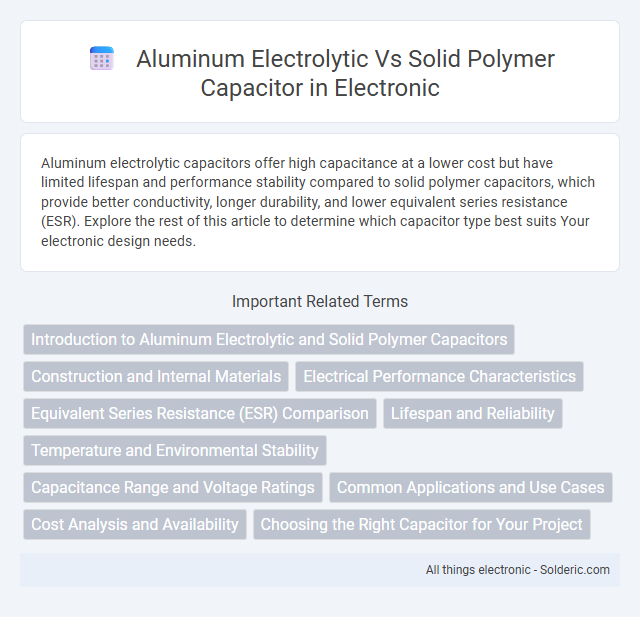Aluminum electrolytic capacitors offer high capacitance at a lower cost but have limited lifespan and performance stability compared to solid polymer capacitors, which provide better conductivity, longer durability, and lower equivalent series resistance (ESR). Explore the rest of this article to determine which capacitor type best suits Your electronic design needs.
Comparison Table
| Feature | Aluminum Electrolytic Capacitor | Solid Polymer Capacitor |
|---|---|---|
| Electrolyte Type | Liquid electrolyte | Solid conductive polymer electrolyte |
| Capacitance Range | 1 uF to several thousands uF | 1 uF to several hundreds uF |
| Equivalent Series Resistance (ESR) | Higher ESR (typically 0.1 - 1 O) | Low ESR (0.005 - 0.1 O) |
| Lifetime | 1,000 to 10,000 hours at 85degC | 5,000 to 20,000 hours at 105degC |
| Reliability | Moderate, prone to drying out and leakage | High, stable over temperature and humidity |
| Operating Temperature | -40degC to 85degC | -55degC to 105degC |
| Size | Larger for same capacitance and voltage | Smaller footprint for same capacitance |
| Cost | Lower cost | Higher cost |
| Typical Applications | Power supply filtering, audio circuits | High-frequency circuits, power management |
Introduction to Aluminum Electrolytic and Solid Polymer Capacitors
Aluminum electrolytic capacitors use a liquid electrolyte to achieve high capacitance values and are commonly employed in power supply filtering and energy storage applications. Solid polymer capacitors replace the liquid electrolyte with a solid conductive polymer, offering improved stability, lower Equivalent Series Resistance (ESR), and enhanced reliability in high-frequency circuits. Both capacitor types are essential in electronic design, with aluminum electrolytic capacitors favored for cost-effectiveness and solid polymer capacitors preferred for performance in demanding environments.
Construction and Internal Materials
Aluminum electrolytic capacitors feature an aluminum foil anode, a liquid electrolyte, and a paper separator soaked in electrolyte, which contributes to their relatively higher equivalent series resistance (ESR) and limited lifespan. Solid polymer capacitors use a conductive polymer as the electrolyte, offering lower ESR, improved stability, and longer durability due to the absence of liquid components. Your choice depends on the application's requirements for performance, longevity, and temperature tolerance, as solid polymer capacitors excel in high-frequency and high-reliability environments.
Electrical Performance Characteristics
Aluminum electrolytic capacitors offer high capacitance values and excellent energy storage but typically exhibit higher equivalent series resistance (ESR) and limited frequency response compared to solid polymer capacitors. Solid polymer capacitors provide lower ESR, higher ripple current capability, and improved thermal stability, resulting in better performance in high-frequency applications and longer lifespan. The choice depends on specific circuit requirements, balancing capacitance, voltage rating, and transient response.
Equivalent Series Resistance (ESR) Comparison
Aluminum electrolytic capacitors typically have higher Equivalent Series Resistance (ESR) compared to solid polymer capacitors, which results in increased heat generation and reduced efficiency in high-frequency applications. Solid polymer capacitors offer significantly lower ESR values, providing better performance and longer lifespan, especially in power supply circuits and high ripple current environments. Understanding the ESR differences helps you select the most suitable capacitor for optimized energy efficiency and reliability in your electronic designs.
Lifespan and Reliability
Aluminum electrolytic capacitors typically have a shorter lifespan of around 2,000 to 10,000 hours at rated temperature, with gradual performance degradation due to electrolyte evaporation, impacting reliability in long-term applications. Solid polymer capacitors offer enhanced reliability and longer lifespan, often exceeding 10,000 hours, due to their stable solid electrolyte which resists drying out and maintains capacitance over time. Choosing solid polymer capacitors improves Your device's durability and operational stability, especially in high-temperature or high-frequency environments requiring consistent performance.
Temperature and Environmental Stability
Aluminum electrolytic capacitors typically operate within a temperature range of -40degC to 85degC, but their performance degrades significantly under high temperatures and humid conditions due to electrolyte evaporation and leakage. Solid polymer capacitors exhibit superior environmental stability, maintaining capacitance and ESR values with minimal variance from -55degC to 125degC, making them ideal for applications requiring long-term reliability in harsh environments. Your choice between these capacitors should consider the thermal demands and exposure to moisture, with solid polymer capacitors providing enhanced stability and lifespan under extreme temperature and environmental stress.
Capacitance Range and Voltage Ratings
Aluminum electrolytic capacitors typically offer a wide capacitance range from 1 uF up to several thousand uF and voltage ratings spanning from 6.3 V to 450 V, making them suitable for high-capacitance, high-voltage applications. Solid polymer capacitors generally provide lower capacitance values, commonly between 1 uF and 470 uF, with voltage ratings from 2.5 V up to 35 V, optimized for stable performance in low-voltage circuits. These differences reflect the trade-offs between capacitance density and voltage tolerance inherent in each capacitor technology.
Common Applications and Use Cases
Aluminum electrolytic capacitors are widely used in power supply filtering, audio equipment, and general-purpose electronics due to their high capacitance and cost-effectiveness. Solid polymer capacitors excel in computing devices, telecommunications, and automotive electronics where low ESR, long life, and stability under high temperatures are critical. Your choice depends on application requirements for performance, longevity, and environmental conditions.
Cost Analysis and Availability
Aluminum electrolytic capacitors generally offer a lower cost and wider availability due to their mature manufacturing process and extensive use in various industries. Solid polymer capacitors, while more expensive, provide enhanced performance characteristics such as lower equivalent series resistance (ESR) and longer lifespan, justifying their higher price in critical applications. Your choice depends on balancing budget constraints with performance requirements, as aluminum electrolytics remain the cost-effective option for large-volume, non-critical settings.
Choosing the Right Capacitor for Your Project
Choosing the right capacitor for your project depends on factors like voltage rating, capacitance stability, ESR, and lifespan. Aluminum electrolytic capacitors offer high capacitance values and cost-effectiveness but have higher Equivalent Series Resistance (ESR) and shorter lifespans compared to solid polymer capacitors. Solid polymer capacitors provide lower ESR, improved thermal stability, and longer durability, making them ideal for applications requiring high reliability and efficient transient response.
Aluminum electrolytic vs solid polymer capacitor Infographic

 solderic.com
solderic.com